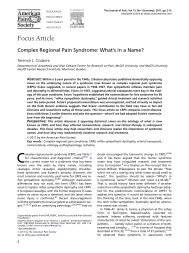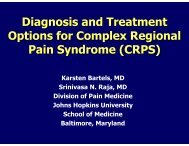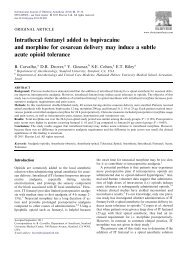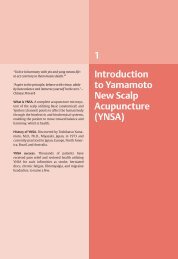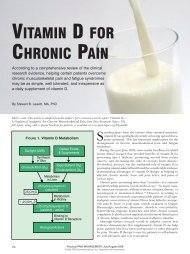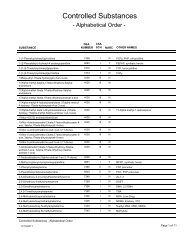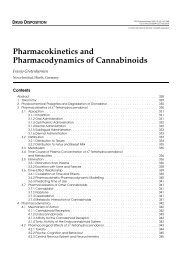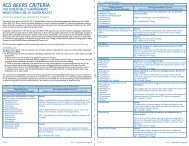GLIA: A NOVEL DRUG DISCOVERY TARGET FOR CLINICAL PAIN
GLIA: A NOVEL DRUG DISCOVERY TARGET FOR CLINICAL PAIN
GLIA: A NOVEL DRUG DISCOVERY TARGET FOR CLINICAL PAIN
Create successful ePaper yourself
Turn your PDF publications into a flip-book with our unique Google optimized e-Paper software.
REVIEWScerebrospinal fluid (CSF) space through an indwellingcatheter would not only be extraordinarily expensivegiven the short half-life of this protein and the cost ofproducing recombinant human IL-10, but also raisesconcerns of infection along the chronic catheter track.Given that IL-10 is an endogenous protein, gene therapycan be employed to drive cells surrounding the CSFspace to produce IL-10 for pain control and obviatethe need for indwelling spinal catheters. Gene therapytechnology is rapidly advancing and new methodologiesindicate that prolonged (many months to years)release of gene-therapy-induced protein can beattained after a single injection of the vector into thespinal CSF space 131 .Importantly, methodologies nowexist which allow the gene therapy to be controlled.That is, vectors can be engineered such that IL-10 productioncan be either activated or deactivated inresponse to systemically administered drugs thatinduce or suppress IL-10 mRNA transcription 132 .Soalthough this IL-10 gene therapy is not yet available forhuman use, this is a potentially exciting new approachfor clinical pain control.SummaryAstrocytes and microglia in the spinal cord are now recognizedas active participants in the creation and maintenanceof pain facilitation induced by inflammationand damage to peripheral tissues, peripheral nerves,spinal nerves and spinal cord. On activation, these gliarelease a variety of neuroexcitatory substances thatpotentiate pain transmission by neurons. Of these glialproducts, pro-inflammatory cytokines seem to be commonspinal mediators of allodynia and hyperalgesia.Given the failure of presently available drugs to provideadequate clinical pain management, this newly recognizedrole of glia is exciting as it predicts novelapproaches for effective pain control by targeting glialactivation. As summarized in this review, several compoundsseem worthy of further development and testingin the hope of reaching clinical trials for this application.Even more importantly, perhaps, is the message topharmaceutical and biotechnology companies thatspinal cord glia are key players in hyperalgesia and allodynia,and are prime targets for new drug developmentaimed at the as-yet-elusive outcome: clinical pain control.1. McQuay, H., Carroll, D., Jadad, A. R., Wiffen, P. & Moore, A.Anticonvulsant drugs for management of pain: a systematicreview. Brit. Med. J. 311, 1047–1052 (1995).2. McQuay, H. J. et al. A systematic review of antidepressantsin neuropathic pain. Pain 68, 217–227 (1996).3. Watkins, L. R. & Maier, S. F. Beyond neurons: Evidence thatimmune and glial cells contribute to pathological pain states.Physiol. Rev. 82, 981–1011 (2002).This article reviews the immunology of peripheralnerves, dorsal root ganglia and spinal nerves; theevidence from animal models of immuneinvolvement in pathological pain; and the evidencethat diverse human clinical pain syndromes involvean immune component.4. Woolf, C. J. & Salter, M. W. Neuronal plasticity: increasingthe gain in pain. Science 288, 1765–1769 (2000).An excellent review of neuronal changes implicated increation and maintenance of exaggerated pain states.5. Pekny, M. in Progress in Brain Research: Glial Cell Funtion(eds Castellano-Lopez, B. & Nieto-Sampedro, M.) 23–30(Elsevier, Amsterdam, 2001).6. Benveniste, E. N. in Neuroglia (eds Kettenmann, H. &Ransom, B. R.) 700–716 (Oxford, New York, 1995).7. Perry, V. H. Macrophages and the Nervous System(Landes, Austin, 1994).8. Gehrmann, J. & Kreutzberg, G. W. in Neuroglia(eds Kettenmann, H. & Ransom, B. R.) 883–904 (Oxford,New York, 1995).9. Araque, A., Parpura, V., Sanzgiri, R. P. & Haydon, P. G.Tripartite synapses: glia, the unacknowledged partner.Trends Neurosci. 22, 208–215 (1999).Synapses can no longer be considered as simply apresynaptic neuron and a postsynaptic neuron.Rather, three entities are involved, the third beingastrocytes. A review of the evidence that astrocytes‘listen’ to neuronal communication and ‘talk back’to the neurons is provided.10. Garrison, C. J., Dougherty, P. M., Kajander, K. C. &Carlton, S. M. Staining of glial fibrillary acidic protein (GFAP)in lumbar spinal cord increases following a sciatic nerveconstriction injury. Brain Res. 565, 1–7 (1991).This research article is historically important as itprovides the first evidence that nerve damage,which creates neuropathic pain, also activatesspinal cord glial11. Garrison, C. J., Dougherty, P. M. & Carlton, S. M. GFAPexpression in lumbar spinal cord of naive and neuropathicrats treated with MK-801. Exp. Neurol. 129, 237–243 (1994).Historically important, this article provides the firstevidence that drugs that inhibit neuropathic pain alsoinhibit glial activation. It provided the first evidencethat, at minimum, neuropathic pain and glial activationare strongly correlated.12. Watkins, L. R., Milligan, E. D. & Maier, S. F. Glial activation:a driving force for pathological pain. Trends Neurosci. 24,450–455 (2001).Evidence is reviewed that spinal cord glia are keymediators in the creation and maintenance ofexaggerated pain states.13. Berg-Johnsen, J., Paulsen, R. E., Fonnum, F. &Langmoen, I. A. Changes in evoked potentials and aminoacid content during fluorocitrate action studied in rathippocampal cortex. Exp. Brain Res. 96, 241–246 (1993).14. Hassel, B., Paulsen, R. E., Johnson, A. & Fonnum, F.Selective inhibition of glial cell metabolism by fluorocitrate.Brain Res. 249, 120–124 (1992).15. Tikka, T. M. & Koistinaho, J. E. Minocycline providesneuroprotection against N-methyl-D-aspartateneurotoxicity by inhibiting microglia. J. Immunol. 166,7527–7533 (2001).16. Meller, S. T., Dykstra, C., Grzbycki, D., Murphy, S. &Gebhart, G. F. The possible role of glia in nociceptiveprocessing and hyperalgesia in the spinal cord of the rat.Neuropharmacology 33, 1471–1478 (1994).Provides the first evidence that disrupting glialactivation blocks exaggerated pain responses. Inaddition, it is the first evidence that activation of glia,in their role as immune cells, is sufficient to induceexaggerated pain responses.17. Watkins, L. R., Martin, D., Ulrich, P., Tracey, K. J. &Maier, S. F. Evidence for the involvement of spinal cord gliain subcutaneous formalin induced hyperalgesia in the rat.Pain 71, 225–235 (1997).18. Milligan, E. D. et al. Thermal hyperalgesia and mechanicalallodynia produced by intrathecal administration of thehuman immunodeficiency virus-1 (HIV-1) envelopeglycoprotein, gp120. Brain Res. 861, 105–116 (2000).19. Milligan, E. D. et al. Spinal glia and proinflammatorycytokines mediate mirror-image neuropathic pain.J. Neurosci. 23, 1026–1040 (2003).20. Raghavendra, V., Tanga, F. & DeLeo, J. A. Inhibition ofmicroglial activation attenuates the development but notexisting hypersensitivity in a rat model of neuropathy.J. Pharmacol. Exp. Ther. 306, 624–630 (2003).Anatomical and pharmacological evidence supportsthe intriguing hypothesis that microglia are key in theinitiation of exaggerated pain states, but thatastrocytes (and not microglia) are crucial for themaintenance of enhanced pain.21. Ledeboer, A. et al. Selective inhibition of spinal cord microglialactivation attenuates mechanical allodynia in rat models ofpathological pain. Proc. Soc. Neurosci. (in the press).22. Cholewinski, A. J., Hanley, M. R. & Wilkin, G. P. Aphosphoinositide-linked peptide response in astrocytes:evidence for regional heterogeneity. Neurochem. Res. 13,389–394 (1988).23. Beaujouan, J. C. et al. Marked regional heterogeneity of125I-Bolton Hunter substance P binding and substanceP-induced activation of phospholipase C in astrocytecultures from the embryonic or newborn rat. J. Neurochem.54, 669–675 (1990).24. Sung, B., Lim, G. & Mao, J. Altered expression and uptakeactivity of spinal glutamate transporters after nerve injurycontribute to the pathogenesis of neuropathic pain in rats.J. Neurosci. 23, 2899–2910 (2003).25. Ochalski, P. A., Frankenstein, U. N., Hertzberg, E. L. &Nagy, J. I. Connexin-43 in rat spinal cord: localization inastrocytes and identification of heterotypic astro-oligodendrocyticgap junctions. Neurosci. 76, 931–945 (1997).26. Li, W. E. & Nagy, I. Activation of fibres in rat sciatic nervealters phosphorylation state of connexin-43 at astrocyticgap junctions in spinal cord: evidence for junction regulationby neuronal–glial interactions. Neurosci. 97, 113–123(2000).27. Palma, C. et al. Functional characterization of substance Preceptors on cultured human spinal cord astrocytes:synergism of substance P with cytokines in inducinginterleukin-6 and prostaglandin E2 production. Glia 21,183–193 (1997).28. Tikka, T., Fiebich, B. L., Goldsteins, G., Keinanen, R. &Koistinaho, J. Minocycline, a tetracycline derivative, isneuroprotective against excitotoxicity by inhibiting activationand proliferation of microglia. J. Neurosci. 21, 2580–2588(2001).29. Bartlett, P. F. Pluripotential hemopoietic stem cells in adultmouse brain. Proc. Natl Acad. Sci. USA 79, 2722–2725(1982).30. Carson, M. J., Reilly, C. R., Sutcliffe, J. G. & Lo, D. Maturemicroglia resemble immature antigen-presenting cells. Glia22, 72–85 (1998).31. Fedoroff, S. in Neuroglia (eds Kettenmann, H. &Ransom, B. R.) 162–184 (Oxford, New York, 1995).32. Lee, J. C., Mayer-Proschel, M. & Rao, M. S. Gliogenesis inthe central nervous system. Glia 30, 105–121 (2000).33. Watkins, L. R., Hansen, M. K., Nguyen, K. T., Lee, J. E. &Maier, S. F. Dynamic regulation of the proinflammatorycytokine, interleukin-1β: molecular biology for non-molecularbiologists. Life Sci. 65, 449–481 (1999).34. Milligan, E. D. et al. Intrathecal HIV-1 envelope glycoproteingp120 induces enhanced pain states mediated by spinalcord proinflammatory cytokines. J. Neurosci. 21,2808–2819 (2001).The first demonstration that activation of spinal cordglia, in their role as immune cells; (i) is sufficient toinduce thermal hyperalgesia and mechanicalallodynia, (ii) induces the production and release ofpro-inflammatory cytokines, and (iii) this proinflammatorycytokine release is causal to theresultant pain enhancement.NATURE REVIEWS | <strong>DRUG</strong> <strong>DISCOVERY</strong> VOLUME 2 | DECEMBER 2003 | 983



